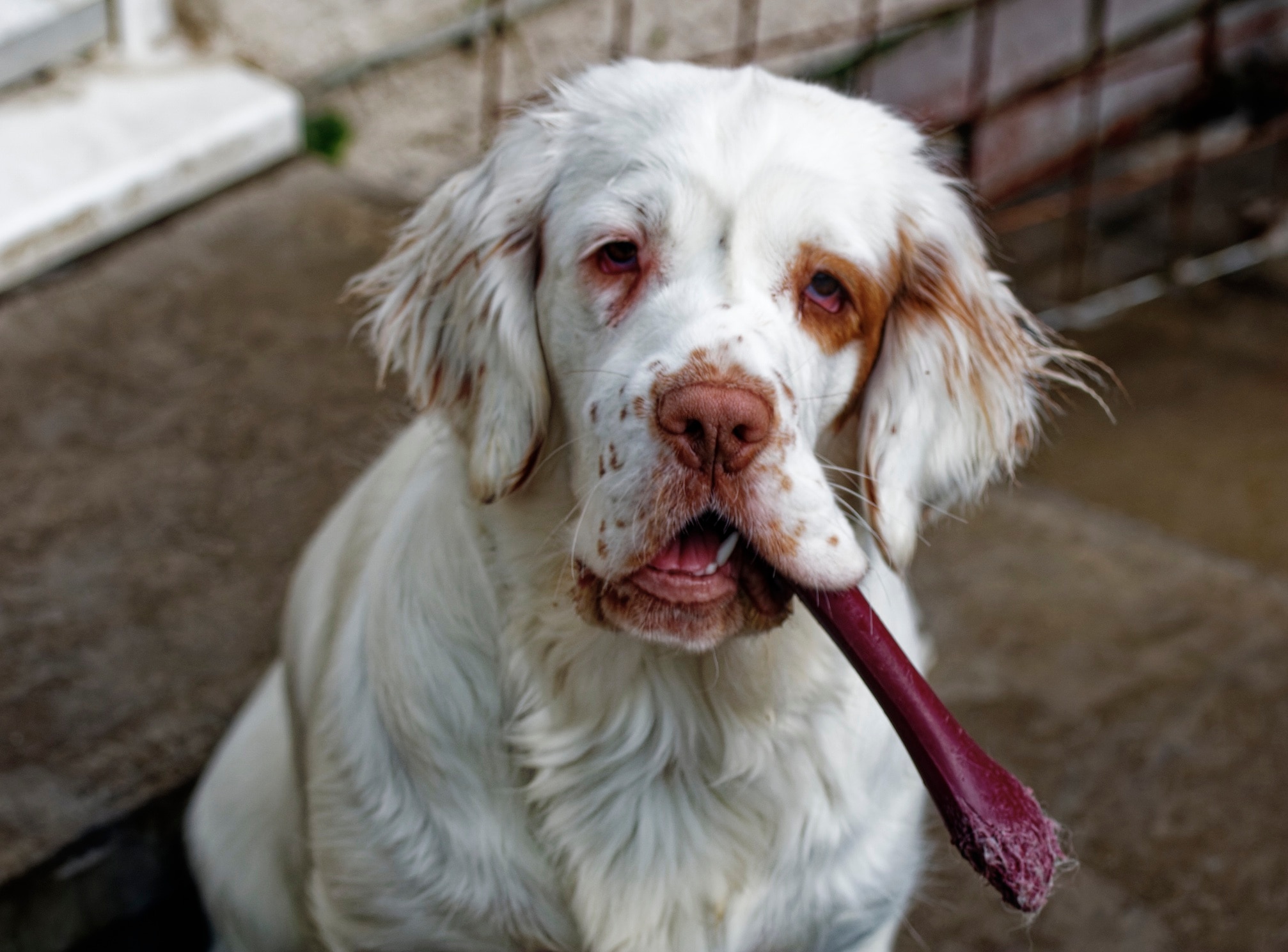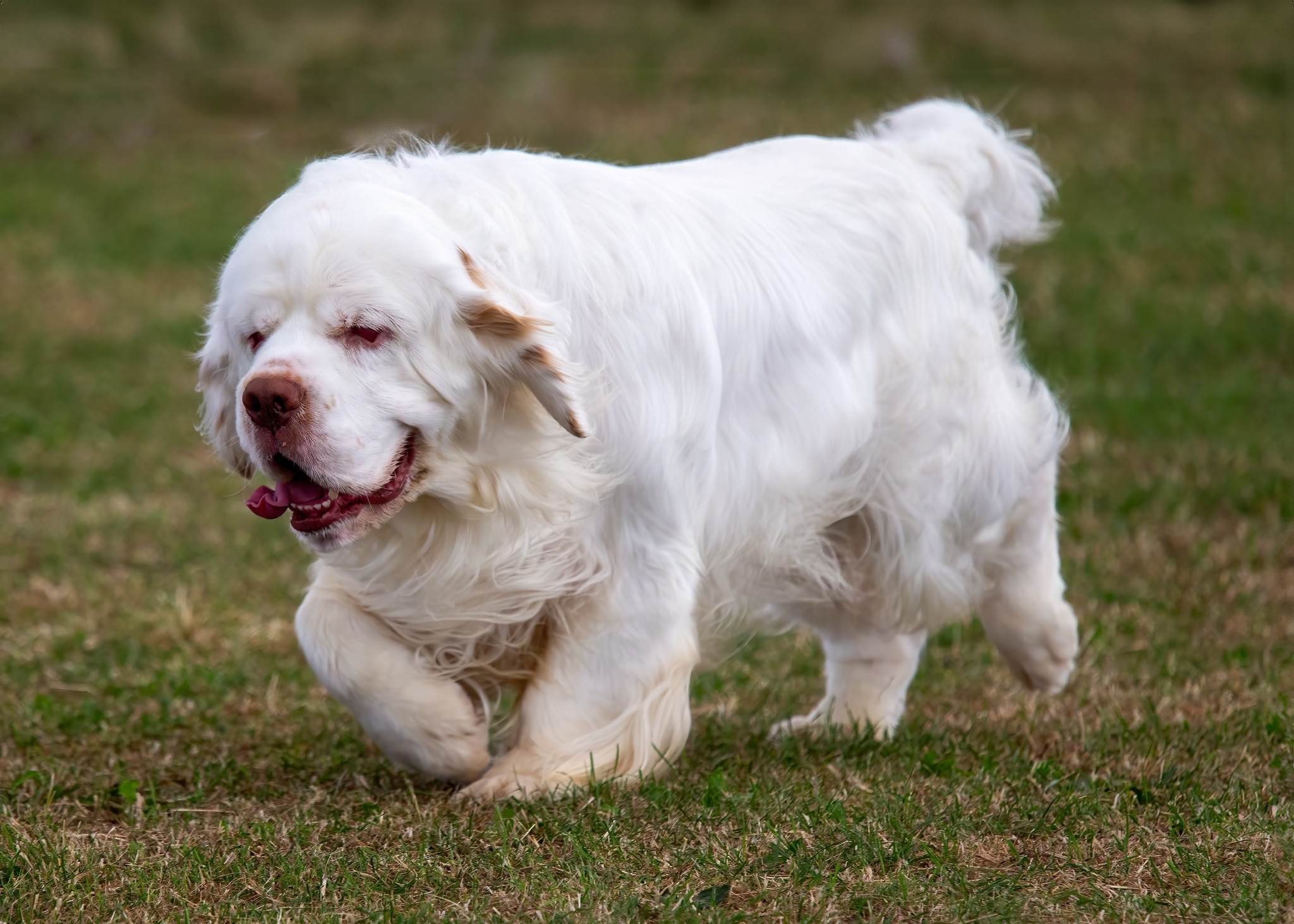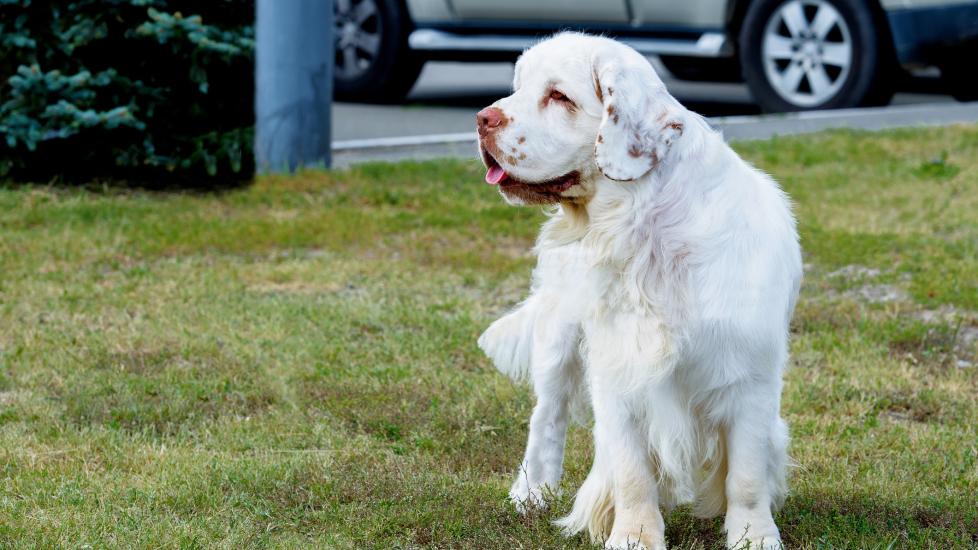Clumber Spaniel
The Clumber Spaniel is an affectionate dog known for their distinctive appearance and friendly nature. Originating in England, the Clumber is one of the oldest spaniel breeds, with a history dating to the 18th century. Named after Clumber Park in Nottinghamshire, the dogs were favored by British nobility and royalty for their talent for retrieving game.
Notable for their heavy build, the Clumber Spaniel is characterized by a large, square head; deep-set eyes; and a robust, low-set body. Despite their size, they are well-mannered and gentle dogs, making them great pets for families. Known for their heightened sense of smell and strong retrieving instincts, Clumber Spaniels have contributed to the development of other popular spaniel breeds.
The Clumber is primarily a white dog with lemon or orange color markings. Typically standing 17–20 inches at the shoulder and weighing 55–85 pounds, this sturdy breed shows great enthusiasm for work and play.
Caring for a Clumber Spaniel
Playful and cheerful, the Clumber Spaniel can be a great family pet with the proper socialization, training, and care. Because of their love for hunting and being outside, however, the breed is not always suitable for city living. These intelligent dogs need regular outdoor exercise and play sessions to be happy and mentally stimulated.
The dense, flat coat of a Clumber Spaniel requires combing at least two or three times a week. Additionally, regular bathing is necessary to keep their coat clean and neat.
Clumber Spaniels are intelligent dogs, but they may display an independent streak. Consistent and positive training methods work well with this breed.
Clumber Spaniel Health Issues
The Clumber Spaniel is a healthy dog with an average lifespan of 10–12 years. But, like all dogs, they may be predisposed to certain health issues.
While not overly prone to severe conditions, responsible pet parents should consider pet insurance to address potential concerns.
Ear Infections
Clumber Spaniels have long, droopy ears that are prone to ear infections. The shape of their ears can restrict air circulation, creating a warm and moist environment ideal for bacteria or yeast to grow.
Regular ear cleaning with a pet-safe ear cleanser is needed to prevent infections. Monitor for signs of redness, swelling, or an unpleasant odor; those symptoms may indicate infection and require veterinary attention.
Hip and Elbow Dysplasia
Hip dysplasia is a genetic condition where the hip joint doesn't fit properly into the hip socket. This is a common issue in larger dog breeds, including the Clumber Spaniel. In severe cases of hip dysplasia, surgical intervention may be necessary.
Elbow dysplasia, where the elbow joint develops abnormally and leads to mobility issues, can also be an issue for Clumbers.
Regular exercise and maintaining a healthy weight through a balanced diet is essential for joint health. Responsible Clumber Spaniel breeders who screen for dysplasia can help reduce the prevalence of this condition.
Intervertebral Disc Disease (IVDD)
IVDD is a condition where the discs between the vertebrae of the spinal column break down, leading to pain, mobility issues, and in severe cases, paralysis. Clumber Spaniels may be predisposed to IVDD due to their long backs.
Pet parents should avoid activities that strain the spine; monitor their dog for signs of pain or weakness; and seek prompt veterinary attention if symptoms arise. Management may involve medication, physical therapy, or, in severe cases, surgery.
Bloat and Gastric Dilatation-Volvulus (GDV)
Gastric dilatation-volvulus (GDV) is a severe form of bloat in dogs in which the stomach inflates and twists, cutting off blood circulation to major abdominal organs. This is a life-threatening emergency, and a dog experiencing bloat or GDV must see an emergency vet immediately. Dogs with deep chests, including Clumber Spaniels, are more susceptible to this condition. Signs include:
-
Distended abdomen
-
Excessive drooling
-
Retching without producing vomit
-
Inability to get comfortable/pacing
To reduce the risk of bloat:
-
Feed your dog multiple smaller meals every day, instead of one big meal
-
Avoid feeding your dog immediately before or after vigorous exercise
-
Avoid using elevated food bowls
-
Use a slow-feeder bowl to slow down your dog’s eating
Entropion
Entropion is a condition where the eyelid rolls inward, causing the hair on the surface to irritate the eye. It can lead to discomfort, tearing, and potential corneal damage. Surgical correction is often necessary.
Allergies
Clumbers can also be prone to allergies. There is no specific cure for dog allergies, but they can be managed medically with the help of a veterinarian. Be alert for signs of allergies in your dog, including:
- Excessive licking, itching, or rubbing
- Red skin
- Loss of fur
- Recurring ear or skin infections
What To Feed a Clumber Spaniel

Choosing the right dog food for a Clumber Spaniel helps support their overall health and well-being. Ensure their dog food provides a balanced and complete diet, meeting the nutritional needs of a large breed like the Clumber Spaniel. Look for products with the Association of American Feed Control Officials (AAFCO) statement on the packaging, indicating that the food meets industry standards.
Clumber Spaniels are prone to certain orthopedic issues, so maintaining a healthy weight is paramount. Choose a dog food with appropriate calorie levels, and consider portion control to prevent obesity.
If your Clumber Spaniel has specific health conditions or allergies, work with your veterinarian to choose an appropriate diet. Some dogs may require specialized formulations, like hypoallergenic or limited-ingredient diets.
Every dog is unique, and nutritional needs can vary. Consult with a veterinarian to determine the specific dietary requirements for your Clumber Spaniel based on their age, weight, health, and activity level.
How To Feed a Clumber Spaniel
Clumber Spaniel puppies, adults, and seniors have different nutritional needs. Choose a dog food that aligns with your dog's age and activity level.
While puppies require more frequent feeding (usually three or four meals per day), adult Clumber Spaniels generally do well with two meals a day to prevent bloat and GDV. Establish a consistent feeding schedule, with meals given at the same times each day. This routine helps regulate your dog's digestion and can be particularly helpful for house training.
Regularly monitor your dog's weight and body condition, and work with your veterinarian to maintain an ideal weight. Obesity can contribute to various health issues, including joint problems.
How Much Should You Feed a Clumber Spaniel?
Determining the right amount of food for a Clumber Spaniel can be a balancing act, as the breed’s energy level, activity level, age, and overall health can all play a role. Most dog food packaging will include recommended feeding amounts based on the dog’s weight.
Still, some adjustments may be needed. Working with your veterinarian can help you find the right amount to feed your dog.
Nutritional Tips for Clumber Spaniels
If your Clumber Spaniel eats a balanced diet that meets the AAFCO’s nutritional standards, they shouldn’t need supplementation in their diet.
That said, your veterinarian may recommend dog supplements depending on your pup’s health needs. This includes joint supplements for supporting joint health and reducing inflammation; omega-3 fatty acids for coat and skin health; and probiotics for digestive health.
Behavior and Training Tips for Clumber Spaniels
Clumber Spaniel Personality and Temperament

Clumber Spaniels are known for their gentle and laid-back temperament. They are affectionate, loyal, and form strong bonds with their family, according to the breed club. Clumber Spaniels enjoy moderate exercise and play, requiring regular walks and interactive activities to keep them mentally stimulated.
Their calm demeanor makes them suitable for many different living situations, and they typically get along well with other pets and children when they are properly socialized as a puppy. Clumber Spaniels benefit from having a job or tasks to fulfill their drive, especially if those tasks are related to their historical role as hunting and retrieving dogs.
Clumber Spaniel Behavior
Clumber Spaniels are not typically known to be anxious or overly fearful. However, individual temperament can vary, and early socialization is imperative to ensure a well-adjusted adult dog.
While not excessively vocal, Clumber Spaniels may bark to alert their family to something unusual. If your Clumber Spaniel tends to bark, use positive reinforcement to encourage quiet behavior. Rewarding silence with treats or praise is more effective than negative reinforcement.
Playful and cheerful, the Clumber Spaniel can be a great family pet with the proper socialization, training, and care. Because of their love for hunting and being outside, however, the breed is not always suitable for city living.
Clumber Spaniel Training
Like every dog, Clumber Spaniel puppies benefit from consistent training and socialization from an early age. They’re an intelligent and eager-to-please breed that can take to training well. Always use positive reinforcement; Clumbers are sensitive dogs, and harsh methods or punishment can be counterproductive, potentially causing anxiety or fear.
Keep training sessions short, engaging, and positive. Long and repetitive sessions may lead to boredom, so incorporating variety can help maintain their interest. It’s a good idea to incorporate mental stimulation into training routines. Clumbers enjoy activities that engage their minds, such as puzzle toys, interactive games, and obedience training that challenges their intellect.
Fun Activities for Clumber Spaniels
-
Nose work
-
Playing fetch
-
Hiking and walking
-
Basic obedience games
-
Tug-of-war
Clumber Spaniel Grooming Guide
Clumber Spaniels have a distinct white coat with lemon or orange markings. It’s dense, flat, water-resistant, and lies close to their body. Their fur sheds moderately year-round, with heavier shedding seasons in the spring and fall, and requires a bit of at-home upkeep.
Skin Care
Regular bathing (about every six to eight weeks) allows you to check for skin issues such as redness, dryness, or lumps. Use a mild dog shampoo to avoid skin irritation.
Regularly check your Clumber Spaniel for ticks and fleas, especially if they spend lots of time outside. Use veterinarian-recommended preventive measures to protect them from these parasites, which can cause skin irritation and transmit diseases.
Coat Care
Clumber Spaniels benefit from regular brushing to prevent matting, remove loose hair, and distribute natural oils. Aim to brush them at least two to three times a week to keep their coat in good condition. Pay special attention to the feathering on their ears, chest, abdomen, and legs, which are more prone to matting.
Eye Care
Clumber Spaniels, like many breeds, can develop tear stains. Wipe the area around their eyes with a damp cloth to remove staining and prevent skin irritation.
Regularly check your Clumber Spaniel's eyes to look for signs of redness, discharge, or other abnormalities. If you notice persistent issues or changes, talk to your veterinarian.
Ear Care
Pay special attention to your Clumber’s ears, as they are prone to infection. Clean their ears as your vet recommends and always after your dog is in water (such as during baths or after swimming).
Some Clumber Spaniels may have hair growing in the ear canal. This hair can trap moisture and debris, contributing to ear problems. Consult with your veterinarian or a professional groomer about safely removing excessive ear hair to promote better airflow.
Considerations for Pet Parents

Affectionate and social Clumber Spaniels thrive in homes that provide them with ample companionship. An ideal home should have time and space for regular exercise. Clumbers, while not extremely high-energy, benefit from daily walks and playtime.
Regular brushing, and attention to feathering areas to prevent matting, is important grooming care. Additionally, their ears should be checked and cleaned regularly. Training should be approached with a gentle and positive method, and pet parents need to prioritize socializing their Clumber Spaniel puppy.
Clumbers are best suited for families and individuals who can offer consistent attention, as they may experience separation anxiety if left alone for extended periods. Homes with a commitment to regular veterinary care, socialization, and mental stimulation provide the best environment for a Clumber Spaniel.
Clumber Spaniel FAQs
Do Clumber Spaniels make good pets?
Yes, Clumber Spaniels generally make excellent pets for the right family or individual who is committed to their training, socialization, and care.
Do Clumber Spaniels like to cuddle?
Yes, Clumber Spaniels are known for their love of cuddling and affection. These dogs form strong bonds with their families and enjoy being close to them.
Are Clumber Spaniels rare?
While not as common as other popular dog breeds, Clumber Spaniels are not considered extremely rare. However, if you’re looking for a Clumber Spaniel puppy, you’re unlikely to find one at a shelter and may have to seek out a responsible breeder.
Featured Image: volofin/iStock / Getty Images Plus via Getty Images
References
The American Kennel Club. The Complete Dog Book. 20th Edition. Penguin Random House. 2006.
